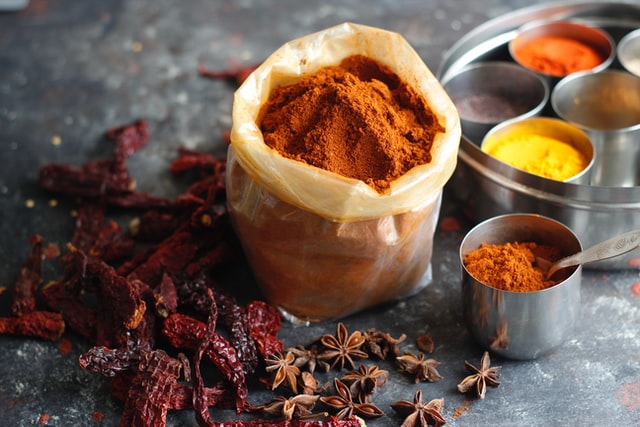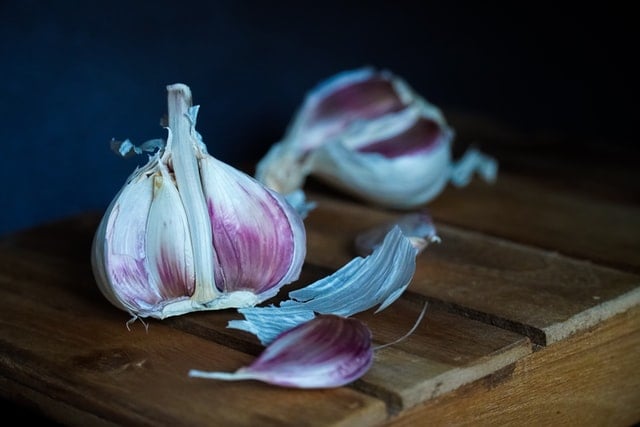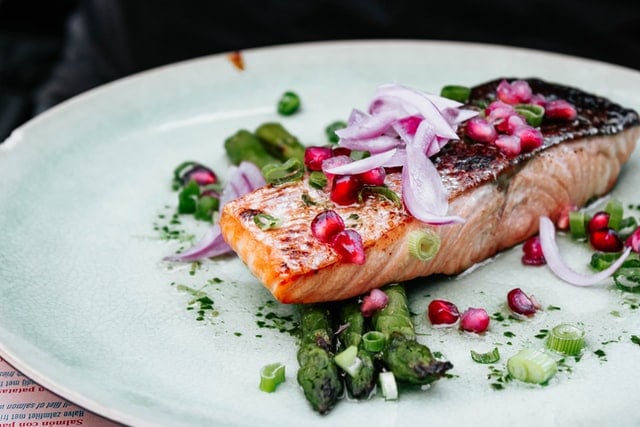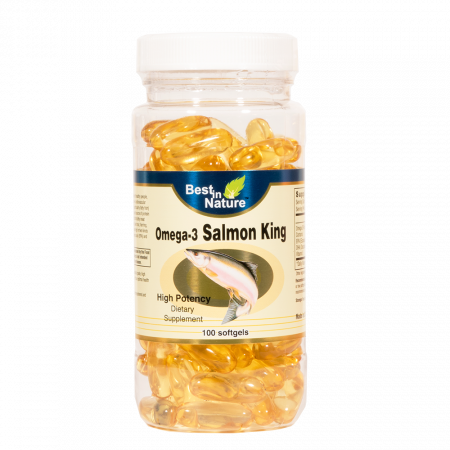
Reviewed and Updated: August 20th, 2024
10 min read
We’ve all heard of the foods that are bad for our heart health, cholesterol levels and blood pressure, but we often forget to ask if there are foods that can actually improve our blood flow and circulation. There’s a saying that “Health starts from the heart.” as proper blood circulation is vital to overall health and getting oxygen and nutrients to the right places.
As it turns out, there are certain foods that can make your heart’s job a little easier. A diet rich in these foods may even reduce your risk of severe conditions like deep vein thrombosis, heart attack, and high blood pressure. This list of 20 runs the range of sweet, savory and spicy.
[Related: OMEGA-3 DEFICIENCY SYMPTOMS AND HOW TO MAKE SURE YOU'RE GETTING ENOUGH]
1. Cayenne Pepper

Cayenne pepper contains large amounts of a phytochemical known as capsaicin, which provides its spicy taste. Capsaicin lowers blood pressure and stimulates the release of vasodilators (compounds that help expand blood vessels in the body), such as nitric oxide. Vasodilators increase circulation by relaxing the tiny muscles in blood vessel walls. Studies show that consuming cayenne pepper makes circulation more efficient, fights plaque buildup in the arteries, and strengthens blood vessels. Moreover, pain-relieving creams commonly include cayenne pepper extract since it can encourage blood flow to the affected area, speeding up the healing process.
Not sure how to use cayenne pepper? Use it to add a bit of bang to your fruit with this Mexican fruit salad recipe!
2. Cinnamon

Cinnamon is a warm, comforting spice commonly used in baking and cooking that offers many health benefits, including increased blood circulation. Research suggests that ingesting cinnamon, in combination with exercise, improves blood vessel dilation and optimizes blood flow in the coronary artery (a major artery supplying blood to the heart). Rats given 91mg per pound of bodyweight of Cinna bark extract every day for two months displayed heightened coronary artery blood flow and heart performance following intense exercise compared to rats who were not given cinnamon in the control group.
Additionally, research illustrates that cinnamon can lower blood pressure in humans effectively by helping to relax your blood vessels. As a result, this delicious spice can improve your circulation and keep your heart healthy. In one study of 59 people with type 2 diabetes, 1,200 mg of cinnamon per day for twelve weeks lowered systolic blood pressure (the higher number of a reading) by an average of 3.4mmHG.
3. Turmeric

Turmeric is a spice that’s been employed by traditional Chinese and Ayurvedic medicine for thousands of years to improve blood circulation and open blood vessels. The active ingredient in turmeric offering is a compound called curcumin, which helps reduce oxidative stress, increase nitric oxide production, and reduce inflammation. In one study of 39 people who ingested 2,000mg of curcumin per day for 12 weeks saw a 36% increase in upper arm blood and a 37% increase in blood flow in their forearm.
You can get turmeric in a convenient supplement form or enjoy this turmeric and lime chicken recipe.
4. Ginger

Ginger is a staple of traditional Asian cooking and a powerful plant used in traditional Asian medicine that can improve circulation and lower blood pressure. In addition to adding a spicy, slightly herbal taste to dishes and teas, ginger has been shown to relieve increased blood pressure in animal and human studies.
In one study of 4,628 people, the participants who consumed the most ginger (2-4 grams per day) had the lowest risk of high blood pressure. Ginger is a vasodilator that reduces blood pressure through widening blood vessels and can be incorporated into everyday cooking, desserts, and beverages. Although ginger can be beneficial, make sure to consult your healthcare provider if you take blood thinners, blood pressure, or diabetes medications.
Check out this recipe for a refreshing ginger tea.
[Related: THE BENEFITS OF LOW-IMPACT EXERCISE FOR YOUR JOINTS AND MORE]
5. Pomegranate

Pomegranates are sweet, juicy fruits filled with edible seeds containing especially high levels of nitrates and antioxidants, which are effective vasodilators. Whether in raw fruit, supplement or juice form, pomegranate may aid oxygenation of muscle tissue and blood flow. Pomegranates’ ability to promote oxygenation and blood flow makes it a beneficial superfood for highly active individuals. One study of 19 active individuals discovered that eating 1,000 mg of pomegranate extract 30 minutes before engaging in intense exercise experienced increased blood vessel diameter, blood flow, and exercise performance. Another study illustrated that consuming 17 ounces of pomegranate juice daily during or before weight training minimized muscle damage, soreness, and inflammation in elite weightlifters.
6. Citrus Fruits

Vitamin C is a key nutrient our bodies cannot create, and which citrus fruits are packed with (along with other essential nutrients). In addition, citrus fruits like grapefruit, oranges, and lemons are filled with various antioxidants that can prevent blood clots, reduce inflammation, and improve overall blood circulation.
7. Tomatoes

Tomatoes are incredibly high in a group of antioxidants known as carotenoids, including beta carotene, lycopene, and vitamin E. Carotenoids are a kind of antioxidant that help aid in blood flow, lower blood pressure, and halt the progression of atherosclerosis.
8. Watermelon

Watermelon is a high-fiber, low-calorie summer fruit that is as nutritious as it is tasty. Florida State University released a study suggesting that watermelon can help combat prehypertension, a precursor to cardiovascular disease. Watermelon is also one of the highest sources of L-citrulline, a compound that can weaken or slow the rise in aortic blood pressure.
9. Bananas

Excess sodium in your diet may be one cause of high blood pressure. Bananas are packed with potassium which helps your body pass this excess sodium and as a result may help to stabilize blood pressure and relax blood vessels.
They’re delicious as they are, but if you want to shake things up try this frozen banana “ice cream” Only one ingredient required!
10. Berries

Berries are famously rich in antioxidants such as anthocyanin. Anthocyanin is particularly good for your heart since it can soften arteries and prevent them from stiffening. Berries also help your body release nitric oxide and decrease inflammation, lowering your overall blood pressure.
11. Grapes

Grapes are another tasty and nutritious fruit that can improve your blood circulation and promote healthier arteries. Purple grapes are packed with potassium and antioxidant polyphenols, which prevent blood platelets from clumping together and forming blood clots. This antioxidant can also decrease blood pressure and reduce inflammation.
One of the noteworthy polyphenols found in grapes is resveratrol. While many people associate resveratrol and its health benefits with drinking red wine, you can actually get these benefits from eating grapes as well.
12. Onions

Onions are rich in quercetin, a powerful antioxidant flavonoid that lowers the risk of cardiovascular diseases. One study found that eating onions every day can increase blood circulation.
It’s worth noting that if you don’t enjoy the taste of onions, that onion extract still provides cardiovascular benefits as found in this study where men were given 4.3 grams of onion extract for 30 days and already indicated some benefit for heart health.
13. Garlic

Garlic is good for more than adding extra flavor to a dish! Garlic is fantastic at boosting the immune system and also boasts high concentrations of pyruvate and allicin, which help prevent cardiovascular disease and blood clots from forming in your bloodstream. Eating raw garlic is the most potent way to enjoy its health benefits, but roasted garlic also has much of the same effects. Like with onion, if you don’t enjoy the taste of garlic, then extracts still provide all of the health benefits in a convenient form.
14. Leafy Greens

Many people know that leafy, green vegetables have high levels of iron. A health benefit that may be lesser-known is that the high levels of nitrates in leafy greens like spinach improve circulation through vasodilation. Eating spinach regularly can lower blood pressure and keep arteries more flexible.
Keep in mind that there are many ways to get your greens! Take kale for example, you can have it in a salad, mix it into a stew, add to stir fry or occasionally make a batch of kale chips.
15. Fatty Fish

Heart-healthy fish such as mackerel, salmon, halibut, and herring are packed with omega-3 fatty acids, which improve blood circulation. Regularly eating fish offers many health benefits, such as keeping your arteries unclogged and lowering your resting blood pressure. In addition, a diet incorporating fish can lower your risk of atherosclerosis, heart attack, and arrhythmia.
Best yet, these fish are extremely tasty and can be prepared in so many ways. Refer to our prior article on Healthy fish to eat for a list of our favorite recipes.
16. Beets

Beets contain naturally high levels of nitrates that your body converts into nitric oxide. This compound has been shown to relax and widen blood vessels. As a result, beets can be powerful for increasing blood flow and lowering blood pressure naturally.
However, beets can be extremely difficult to eat for many people due to their strong, earthy taste. Instead, you can try juicing them and blending with orange and other fruit juices. Participants in a placebo-controlled study on beet juice showed reduced blood pressure, clotting time and blood vessel inflammation with only 5 ounces of beet juice per day.
17. Dark Chocolate

Who doesn’t love chocolate? As it turns out, certain chocolate can contribute to better blood flow and circulation. Dark chocolate (with at least 85 percent cocoa) contains polyphenols that help lower oxidative stress and form more nitric oxide, assisting blood vessel dilation and blood flow.
Chocolate with this much Cacao will be more bitter than the chocolate many people are used to so complement them with sweet fruits like banana, mango, figs, pears, and, of course, strawberries for a pairing bursting with vitamins and antioxidants.
18. Walnuts

Walnuts are a healthy snack and a source of a type of omega-3 fatty acid called alpha-linolenic acid (ALA), which helps blood flow more efficiently. Walnuts also have some of the highest antioxidant activity of any nut due to the compounds contained within which include Vitamin E, phosphorus, magnesium and melatonin.
19. Sunflower Seeds

Sunflower seeds are tiny but mighty parcels of essential nutrients. Sunflower seeds contain high quantities of proteins, healthy fats, fiber, selenium, phytochemicals, vitamin E, copper, and magnesium. In addition, sunflower seeds are an excellent source of magnesium, which improves blood flow, lowers blood pressure (just make sure they’re unsalted) and aids in building strong bones.
20. Ginkgo Biloba

Ginkgo is one of the oldest living tree species in the world. An extract made from the tree’s leaves is one of the most popular herbal supplements in Asia, Europe and the United States. Ginkgo has been used for millennia to treat memory issues and blood disorders. Today, ginkgo is known for keeping your memory sharp. In fact, laboratory studies illustrate how ginkgo optimizes blood circulation by making blood less sticky and opening up blood vessels. With all of these powerful nutrients, ginkgo boasts various medical benefits like improving eye and vein health. Along with vein health and blood flow, ginkgo may also assist with treating dementia and intermittent claudication (or poor circulation in the legs).
Ginkgo leaves also contain many antioxidants like terpenoids and flavonoids, which fight harmful free radicals that are linked to many age-related illnesses. Always make sure to consult your doctor if you take anticoagulants, blood pressure, and antiinflammatory medications due to drug interactions.
[Related: THE 9 MOST IMPORTANT VITAMINS AND MINERALS FOR BONE HEALTH]
Heart-Healthy Supplements from Best in Nature*
CoQ10 100 mg softgels
VigorHeart Multi-Ingredient Heart Health formula combining CoQ10 with traditional herbs
Omega-3 Salmon King high-potency fish oil with more EPA and DHA than the leading fish oil supplements on the market.
NattoBest an isolated enzyme extract from the famous heart-healthy Japanese soy food Natto
Bottom Line
There you have it. 20 tasty foods that can help to increase blood flow and circulation. As you might have already suspected, healthy blood flow and circulation is the result of a healthy diet, regular physical activity and other healthy lifestyle choices. While you’re not going to be able to work all of these foods into your diet everyday, making smart swaps and reworking some of your regular recipes or snacks can help in improving your circulation and overall health.
Any favorites that we didn’t mention? Comment them below!
* This article is for informational purposes only and doesn’t constitute medical advice. For immediate health concerns, please consult your physician.
These statements have not been evaluated by the Food and Drug Administration. Products are not intended to diagnose, treat, cure or prevent disease.
© 2024 Best in Nature All rights reserved










Validate your login
Sign In
Create New Account